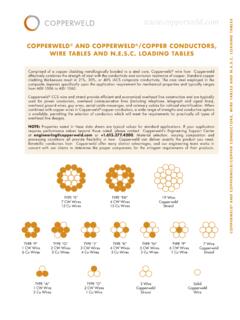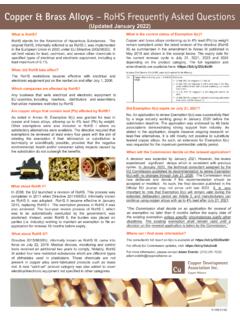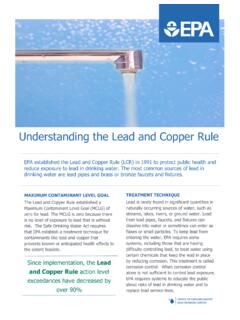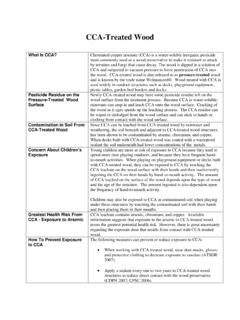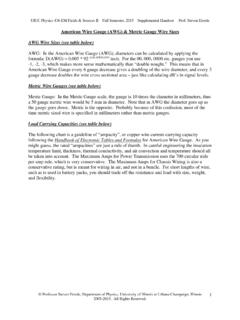Transcription of Nomenclature Packet - Mr. Midtgard's Chemistry Class
1 Page 1 Nomenclature Packet Worksheet I: Binary Ionic Compounds (representative metals) metals from groups 1A, 2A, and 3A (1, 2, and 13) have constant charges as ions and do NOT get Roman Numerals in their names 1. Name the following ionic compounds: a. Al2O3 Aluminum oxide b. Cs2O Cesium oxide c. Rb3N Rubidium nitride d. Ca3N2 Calcium nitride e. SrSe Strontium selenide f. Cs2S Cesium sulfide g. Al2S3 Aluminum sulfide h. LiBr Lithium bromide i. Mg3N2 Magnesium nitride j. CaF2 Calcium fluoride 2. Write the chemical formula for the following ionic compounds: a. Barium nitride Ba+2 N-3 Ba3N2 b. Indium Fluoride In+3 F-1 InF3 c. Calcium oxide Ca+2 O-2 CaO d. Sodium nitride Na+1 N-3 Na3N e. Magnesium chloride Mg+2 Cl-1 MgCl2 f. Potassium oxide K+1 O-2 K2O g. Magnesium oxide Mg+2 O-2 MgO h. Potassium sulfide K+1 S-2 K2S i. Lithium nitride Li+ N-3 Li3N j. Strontium fluoride Sr+2 F-1 SrF2 k.
2 Aluminum sulfide Al+3 S-2 Al2S3 l. Duplicate problem - removed Page 2 Worksheet 2: Binary Ionic Compounds (variable charge metals) metals from groups 3 12 and 14 or 4A (Pb and Sn) charge of anion is constant use charge of anion to figure out charge of metal 1. Name the following ionic compounds: a. SnO2 oxide = O-2 Tin (IV) oxide b. Mn2O7 oxide = O-2 Manganese (VII) oxide c. FeN nitride = N-3 Iron (III) nitride d. Cu3N2 nitride = N-3 copper (II) nitride e. TiF3 fluoride = F-1 Titanium (III) fluoride f. Cu2S sulfide = S-2 copper (I) sulfide g. Fe2S3 sulfide = S-2 Iron (III) sulfide h. CuBr bromide = Br-1 copper (I) bromide i. Co3N2 nitride = N-3 Cobalt (II) nitride j. CoF2 fluoride = F-1 Cobalt (II) fluoride 2. Write the formula for the following ionic compounds: a. copper (I) nitride Cu3N b. Cobalt (I) fluoride CoF c. Titanium (IV) oxide TiO2 d. Iron (II) nitride Fe3N2 e.
3 Iron (III) chloride FeCl3 f. copper (II) oxide CuO g. Rhodium (II) oxide RhO h. Tin (IV) sulfide SnS2 i. Manganese (IV) nitride Mn3N4 j. copper (I) fluoride CuF k. Cobalt (II) sulfide CoS l. Iron (III) oxide Fe3O2 Page 3 Worksheet 3: Binary Covalent Compounds 1. Name the following covalent compounds: a. CO Carbon monoxide b. CO2 Carbon dioxide c. NO Nitrogen monoxide d. NO2 Nitrogen dioxide e. SF6 Sulfur hexafluoride f. SiF4 Silicon tetrafluoride g. N2S3 Dinitrogen trisulfide h. B2H6 Diboron hexahydride i. SO2 Sulfur dioxide j. CH4 Carbon tetrahydride 2. Write the formula for the following covalent compounds: a. Boron trichloride BCl3 b. Nitrogen monoxide NO c. Dinitrogen monoxide N2O d. Dinitrogen pentoxide N2O5 e. Sulfur hexachloride SCl6 f. Carbon monoxide CO g. Carbon disulfide CS2 h. Oxygen difluoride OF2 i. Dinitrogen tetrahydride N2H4 j. Silicon tetrahydride SiH4 Page 4 Worksheet 4: Mixing up Binary Compounds 1.
4 Name the following binary compounds: a. CuO copper (II) oxide b. SrO Strontium oxide c. B2O3 Diboron trioxide d. TiCl4 Titanium (IV) chloride e. K2S Potassium sulfide f. OF2 Oxygen difluoride g. NH3 Nitrogen trihydride h. VF5 Vanadium fluoride i. CuCl copper (I) chloride j. MnO2 Manganese (IV) oxide k. MgO Magnesium oxide l. B2H6 Diboron hexahydride 2. Write the formula for the following binary compounds: a. Phosphorous trichloride PCl3 b. Chlorine monofluoride CF c. copper (II) chloride CuCl2 d. copper (I) sulfide Cu2S e. Calcium nitride Ca3N2 f. Carbon tetrabromide CBr4 g. Lithium oxide Li2O h. Potassium chloride KCl i. Titanium (IV) bromide TiBr4 j. Magnesium sulfide MgS k. Manganese (II) nitride Mn3N2 Page 5 Worksheet 5: Ionic Compounds with Polyatomic Ions 1. Name the following ionic compounds: a. Co(NO3)2 Cobalt (II) nitrate b. NaNO2 Sodium nitrite c. Cu3(PO3)2 copper (II) phosphite d.
5 Ba(CN)2 Barium cyanide e. Al2(SO4)3 Aluminum sulfate f. KClO3 Potassium chlorate g. CuC2H3O2 copper (I) acetate h. Fr2C2O4 Francium oxalate i. NH4Cl Ammonium chloride j. PbPO4 Lead (III) phosphate k. Ba(OH)2 Barium hydroxide l. KClO Potassium hypochlorite 2. Write the formula for the following ionic compounds: a. Rhodium (II) chromate RhCrO4 b. Lithium hydroxide LiOH c. Sodium permanganate NaMnO4 d. Manganese (III) nitrate Mn(NO3)3 e. Barium nitrite Ba(NO2)3 f. Aluminum hypochlorite Al(ClO)3 g. Potassium phosphate K3PO4 h. copper (I) acetate CuC2H3O2 i. Ammonium bromide NH4Br j. Sodium carbonate Na2CO3 k. Lithium chlorite LiClO2 Page 6 Worksheet 6: Putting it All Together 1. Name the following compounds: a. Fe(NO3)3 Iron (III) nitrate b. CaSO4 Calcium sulfate c. NaCl Sodium chloride d. K2SO4 Potassium sulfate e. CO2 Carbon dioxide f. SF6 Sulfur hexafluoride g. KClO Potassium hypochlorite h.
6 N2O5 Dinitrogen pentoxide i. IF5 Iodine pentafluoride j. Co(MnO4)2 Cobalt (II) permanganate k. Sn(SO4)2 Tin (IV) sulfate l. FrCl Francium chloride 2. Write the formula for the following compounds: a. Trinitrogen dioxide N3O2 b. Lithium phosphate Li3PO4 c. Ammonium chloride NH4Cl d. copper (II) chlorite Cu(ClO2)2 e. Nitrogen monoxide NO f. Iron (II) iodide FeI2 g. Calcium phosphate Ca3(PO4)2 h. Dinitrogen dioxide N2O3 i. Magnesium oxide MgO j. Iron (III) chromate Fe2(CrO4)3 k. Sulfur dioxide SO2
